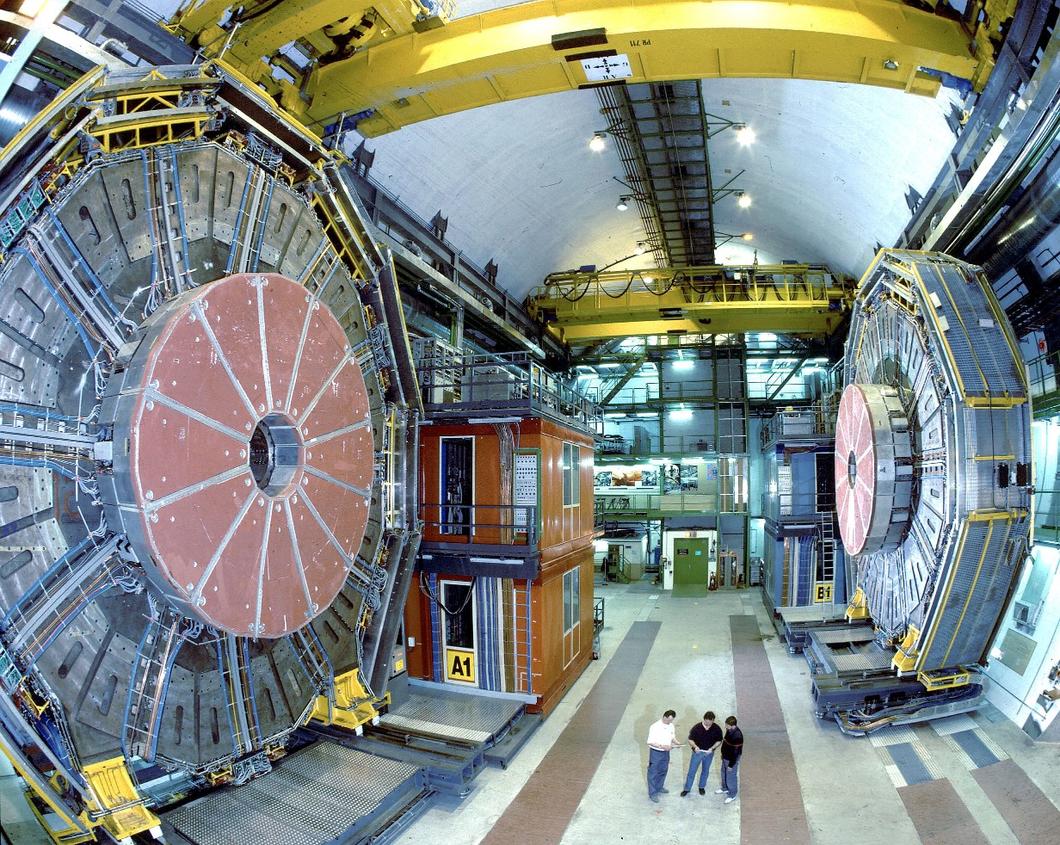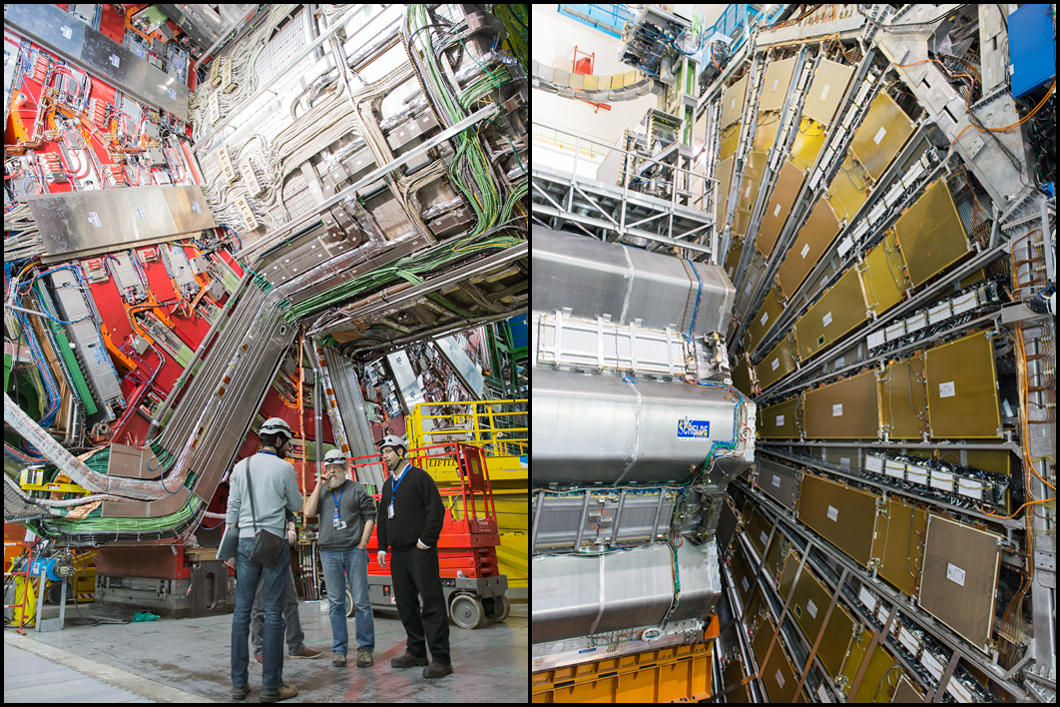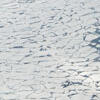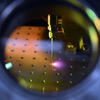You are here
The Titans of CERN
10.15.2015, by
The LHC, which has led to the discovery of the Higgs boson, is the largest scientific facility ever built by man. It is the latest in a long line of monumental instruments built over the past 60 years at CERN to unravel the secrets of matter.

1
Slideshow mode
Operational since 2009 and buried 100 m under the Franco-Swiss border, the 27-kilometre Large Hadron Collider (LHC) accelerates two particle beams travelling in opposite directions.
CNRS Photothèque / Cyril FRÉSILLON

2
Slideshow mode
Particle collisions occur where the beams interact, at four specific locations where the giant detectors Alice, Atlas, CMS and LHCb, are installed.
CERN / Illustration Philippe Mouche

3
Slideshow mode
These collisions produce a number of particles, such as quarks and beauty antiquarks, mostly observed by the LHCb detector. The objective: to study the differences between matter and antimatter.
CNRS Photothèque / Cyril FRÉSILLON

4
Slideshow mode
CERN’s first accelerator, the 600 MeV Synchrocyclotron (SC) comes into operation in 1957. It will provide beams for CERN’s first particle and nuclear physics experiments until 1990.
1957 CERN

5
Slideshow mode
The ring-shaped Proton Synchrotron (PS), which becomes operational in 1960, is the most powerful proton accelerator of its time. Still active today, it continues to supply particle beams to the Large Hadron Collider (LHC).
1965 CERN

6
Slideshow mode
Since 1967, the Isolde facility produces unstable radioactive nuclei. Their study is useful to nuclear physics, medicine, and electronics.
2013 CERN

7
Slideshow mode
During the 1950s and 1960s, bubble chambers allowed scientists to observe particle trajectory. One of these was CERN’s Big European Bubble Chamber, used in the 1970s. Particles generate bubbles as they pass through liquid hydrogen maintained at close to boiling point.
1971 CERN

8
Slideshow mode
In 1968, Nobel prizewinner Georges Charpak (left) brings particle detection into the electronic age with the “multi-wire proportional chamber” (MWPC), which allows for a 1000-fold increase in detection rate.
1970 CERN

9
Slideshow mode
The Intersecting Storage Rings (ISR), the first proton collider in the world, will operate between 1971 and 1989. Made up of two identical 300-meter rings that intersect at 8 points, the machine, whose beams are supplied by the Proton Synchrotron (PS), allowed scientists to determine that protons were made up of smaller particles.
1983 CERN

10
Slideshow mode
Used between 1972 and 1996, the Omega spectrometer is equipped with a 15,000-ton superconducting magnet. Extremely versatile, Omega was used for a whopping 48 experiments.
1972 CERN

11
Slideshow mode
This bubble chamber, called Gargamelle due to its very large size, detected "weak neutral currents" in 1973, a crucial phenomenon for understanding the world of particles. The experiment uses a beam of neutrinos, very elusive particles that are very sensitive to this phenomenon.
1970 CERN

12
Slideshow mode
Completed in 1976, the 7km-long Super Proton Synchrotron (SPS) was the first giant underground ring to cross the Franco-Swiss border. Today, it accelerates particles before feeding them to the LHC.
1976 CERN

13
Slideshow mode
In 1983, CERN announces the discovery by the UA1 (pictured) and UA2 detectors, of the W and Z bosons, which mediate the weak fundamental force on particles.
1981 CERN

14
Slideshow mode
In operation from 1989 to 2000, the Grand electron-positron collider (LEP) was installed in a tunnel 27 kilometers dug for the occasion, one that houses the LHC today. It is fed with particles by the SPS.
1987 CERN

15
Slideshow mode
Four versatile detectors were installed on the LEP to observe collisions between electrons and high-energy positrons: Aleph (pictured here), Delphi, L3, and Opal.
1996 CERN

16
Slideshow mode
The Antiproton Decelerator (AD) is a unique instrument, which since 2000, produces low-energy antiprotons particularly used to explore the properties of antimatter.
2011 CERN

17
Slideshow mode
In the early 2000s, NA50, an experiment dedicated to the study of heavy ions, helps describe "quark-gluon plasma:" a very special state of matter that might have existed a few microseconds after the Big Bang.
1995 CERN

18
Slideshow mode
Study of "quark-gluon plasma" continues today with the Alice detector. Collisions between lead ions recreate the conditions necessary for the formation of this state of matter: extreme density and temperatures.
CNRS Photothèque / Cyril FRÉSILLON

19
Slideshow mode
In 2012, the LHC’s ATLAS (right) and CMS (left) experiments observe a new particle consistent with the Higgs boson, a key elementary particle in the Standard Model of particle physics.
CNRS Photothèque / Cyril FRÉSILLON

20
Slideshow mode
The LHC will operate another two decades to further investigate the Higgs boson, and identify and describe unknown phenomena—known as "new physics." In the longer term, CERN plans to build a 100 km Collider, the FCC project (Future circular collider), which would make it possible to investigate an even wider range of energy.
CNRS Photothèque / Cyril FRÉSILLON
Explore more
Matter
Article
10/27/2025
Slideshow
07/17/2025
Article
07/07/2025
Article
03/26/2025
Slideshow
03/19/2025
Physics
Article
07/07/2025
Slideshow
03/19/2025
Article
01/14/2025
Article
04/09/2024
Article
01/24/2024









